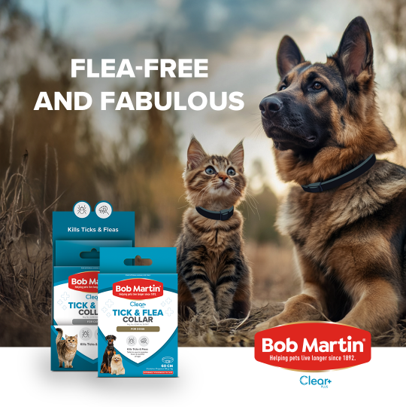The spring and summer seasons in South Africa are a wonderful time, especially if you have a much-loved furry friend that you can take on outdoor adventures. But, sometimes, uninvited guests arrive, such as ticks and fleas. Fear not. Preventing ticks and fleas as well as defleaing your pet if they do become an issue is simple with the correct products and care.
Finding the flea
Different remedies are needed to get a parasite infestation under control. A good way to check for fleas is to run a flea comb through your dog or cat’s fur or to stroke the hair just above the tail base upwards, if you see either fleas or little granules that look like ground coffee, you unfortunately have a flea problem. The little black granules you see are actually flea droppings and is made up of dried blood. A tell-tale sign is also hair loss just above the tail base.
A tick and flea shampoo or a dip will help to kill all fleas on your pet immediately. As these products have short activity, it is necessary to use a longer acting product like a tick and flea spot on, spray or collar to ensure long-term coverage. Products such as Bob Martin Clear Spot-on powders, shampoos and Spray are specifically formulated for the treatment of ticks and fleas in dogs and cats.

Image credit: Supplied
It is VERY IMPORTANT to use dog only products only on dogs. Some dog products are highly poisonous to cats, so should never be used on or close to cats. Please always read your package instructions carefully and consult your vet for further advice.
Regular, once monthly treatments are necessary to get rid of a flea infestation as fleas do not live on animals, but in the environment and only jump on a pet to have a blood meal and will jump off again shortly after.
As fleas prefer dark areas like cracks where the floor meets the wall, under beds, carpets and especially in between wooden flooring panels, it is vitally important to also treat the environment with either a tick and flea powder or environmental spray with residual action against hatching fleas.
Dr Jan, Bob Martin’s consulting vet explains that: “During the lifecycle, some stages are resistant to products. This means that, even though there is a comprehensive treatment, this may need to be repeated as those stages will still continue developing. The area must also be properly cleaned, swept and vacuumed, including carpets and along the edges of walls. A flea powder can also be used on pet bedding to kill fleas dropping off to lay eggs or hatching in the bedding.”
It’s not uncommon for pet parents to be unaware that their dog or cat has fleas, especially if there are fewer than 3-5 fleas on your pet. This is why it’s important to continue defleaing treatment all year round, even in winter when the flea life cycle slows down. Every flea lays 40 to 50 eggs, so if fleas are not treated in winter, it allows the flea population to grow exponentially during these months silently.
Dr Jan adds, “Once an infestation is under control, prevention can be relatively easy by continuing with once monthly treatment and also keeping the environmental clean and treated.”
Spot on!
Don’t put off summer hikes with your pooch for fear of fleas, those small critters can be prevented and treated effectively when armed with your amazing fur parent skills and the right treatment options and advice.
Bob Martin‘s tick, flea & mites treatment and prevention products are a simple and effective solution to keep your pets (and you) happy and healthy.
ALSO SEE:
Pets and anxiety: Understand your pet’s anxious behaviour + expert tips on treatment options
Feature image: Supplied

